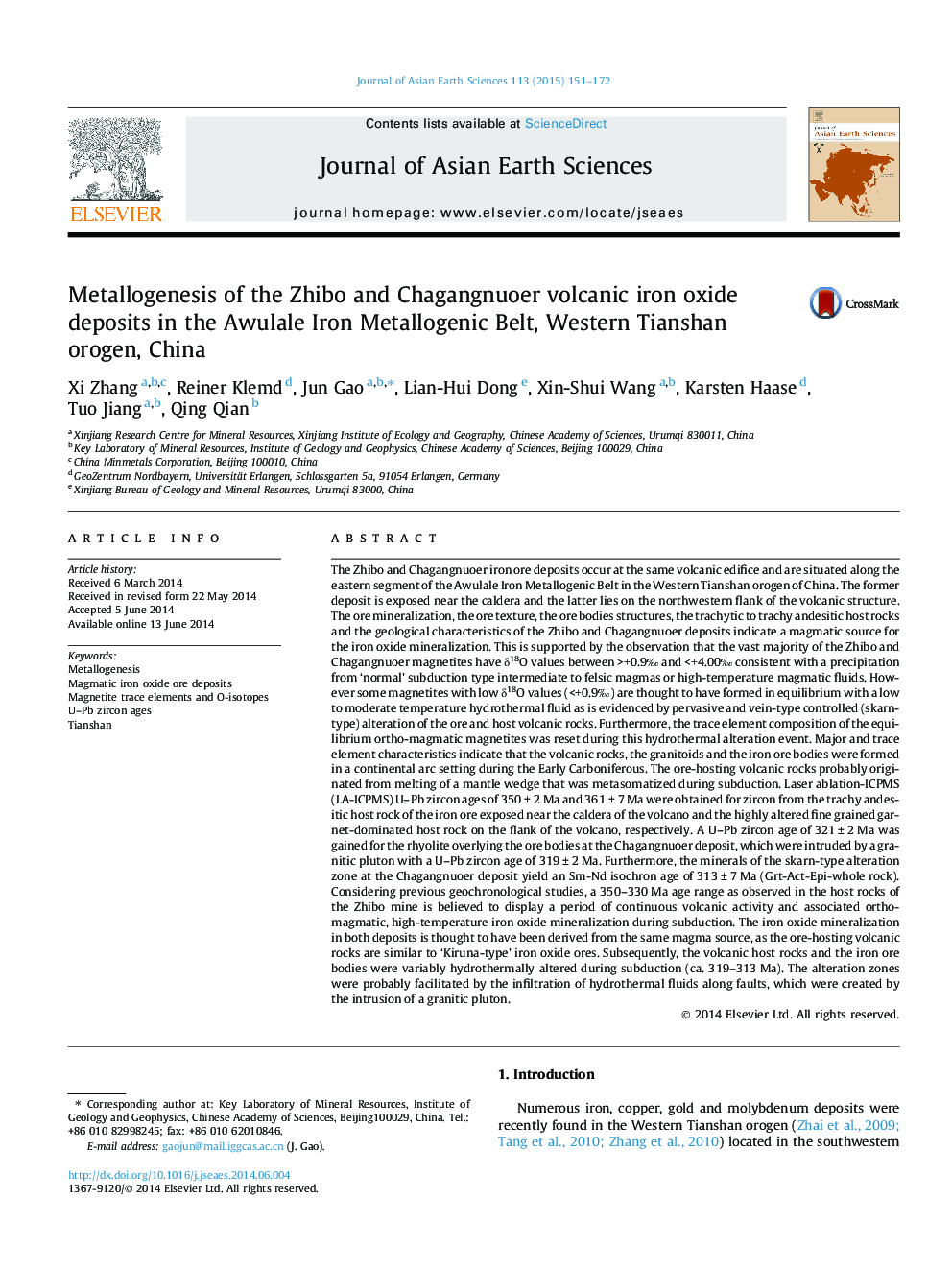| کد مقاله | کد نشریه | سال انتشار | مقاله انگلیسی | نسخه تمام متن |
|---|---|---|---|---|
| 4730221 | 1356743 | 2015 | 22 صفحه PDF | دانلود رایگان |

• Two iron deposits were generated in a continental arc-setting.
• We favor a magmatic origin for the iron oxide mineralization.
• The mineralization is related to the magmatic evolution of the same volcano.
• The mineralization of both deposits occurred between ca. 350 and 330 Ma.
• Both deposits were hydrothermally overprinted between ca. 319 and 313 Ma.
The Zhibo and Chagangnuoer iron ore deposits occur at the same volcanic edifice and are situated along the eastern segment of the Awulale Iron Metallogenic Belt in the Western Tianshan orogen of China. The former deposit is exposed near the caldera and the latter lies on the northwestern flank of the volcanic structure. The ore mineralization, the ore texture, the ore bodies structures, the trachytic to trachy andesitic host rocks and the geological characteristics of the Zhibo and Chagangnuoer deposits indicate a magmatic source for the iron oxide mineralization. This is supported by the observation that the vast majority of the Zhibo and Chagangnuoer magnetites have δ18O values between >+0.9‰ and <+4.00‰ consistent with a precipitation from ‘normal’ subduction type intermediate to felsic magmas or high-temperature magmatic fluids. However some magnetites with low δ18O values (<+0.9‰) are thought to have formed in equilibrium with a low to moderate temperature hydrothermal fluid as is evidenced by pervasive and vein-type controlled (skarn-type) alteration of the ore and host volcanic rocks. Furthermore, the trace element composition of the equilibrium ortho-magmatic magnetites was reset during this hydrothermal alteration event. Major and trace element characteristics indicate that the volcanic rocks, the granitoids and the iron ore bodies were formed in a continental arc setting during the Early Carboniferous. The ore-hosting volcanic rocks probably originated from melting of a mantle wedge that was metasomatized during subduction. Laser ablation-ICPMS (LA-ICPMS) U–Pb zircon ages of 350 ± 2 Ma and 361 ± 7 Ma were obtained for zircon from the trachy andesitic host rock of the iron ore exposed near the caldera of the volcano and the highly altered fine grained garnet-dominated host rock on the flank of the volcano, respectively. A U–Pb zircon age of 321 ± 2 Ma was gained for the rhyolite overlying the ore bodies at the Chagangnuoer deposit, which were intruded by a granitic pluton with a U–Pb zircon age of 319 ± 2 Ma. Furthermore, the minerals of the skarn-type alteration zone at the Chagangnuoer deposit yield an Sm-Nd isochron age of 313 ± 7 Ma (Grt-Act-Epi-whole rock). Considering previous geochronological studies, a 350–330 Ma age range as observed in the host rocks of the Zhibo mine is believed to display a period of continuous volcanic activity and associated ortho-magmatic, high-temperature iron oxide mineralization during subduction. The iron oxide mineralization in both deposits is thought to have been derived from the same magma source, as the ore-hosting volcanic rocks are similar to ‘Kiruna-type’ iron oxide ores. Subsequently, the volcanic host rocks and the iron ore bodies were variably hydrothermally altered during subduction (ca. 319–313 Ma). The alteration zones were probably facilitated by the infiltration of hydrothermal fluids along faults, which were created by the intrusion of a granitic pluton.
Journal: Journal of Asian Earth Sciences - Volume 113, Part 1, 1 December 2015, Pages 151–172